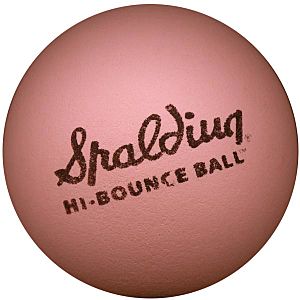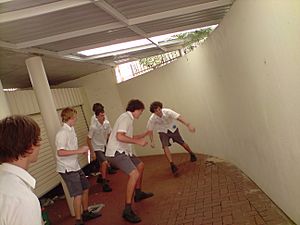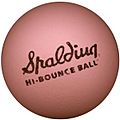Wallball facts for kids

Wallball is a fun game often played in schoolyards. It's a bit like other handball games, such as Gaelic handball, Chinese handball, or American handball. Kenny Mott is known as the person who started the sport. It began in a few schools in Brandon, Manitoba, and then became very popular around the world! Today, Wall Ball International helps promote the game globally. In Wallball, you usually hit the ball to the ground first, and then it bounces up to hit a wall. It can be played by one person against another (singles), by two teams (doubles), or as an elimination game where players get knocked out.
Wallball came from many street games played by kids in New York City. These games often used bouncy balls, like the ones made by Spalding in 1950. A cool trick called the "penguin trick" was first seen in Wallball. Carlos Leitão from Portugal did this trick during a handball qualification game.
Contents
How to Play Wallball
The main goal of Wallball is to be the last player left in the game. You want to get all other players out! A game needs at least two players and usually lasts less than 10 minutes. All you need is a bouncy ball.
The idea is to hit the ball against a wall. If a player hits the ball and it bounces out of the playing area, the next player in line might lose a life.
Starting the Game
First, players decide who serves. This can be the winner of the last game, the person who found the ball, or a new player joining. The server hits the ball forward and down. It must hit the ground first, then bounce up to hit the wall. If the ball bounces more than once before hitting the ground, or if it hits the wall before hitting the ground, it's usually considered "out."
Keeping the Ball in Play
After the ball hits the wall, it bounces back. The next player then does the same thing. If the ball bounces more than once before the second player hits it, that player is out. However, hitting the ball before it bounces at all is allowed after the first person serves.
Boundaries and "Lineys"
If the ball bounces outside the playing area (which usually has orange lines), it's "out." If the ball hits an orange line, it's sometimes "in," sometimes "out," or sometimes called a "liney" or "liner." A "liney" means the game stops, and the person who hit it serves again. The goal is to hit the ball with the right power and direction to make it hard for the next player, causing them to get out. Sometimes, there's a "first serves" rule where the server doesn't get out until they make a mistake three times.
Special Shots
There are many different rules, but the ones above are the most common.
- Babies: This is when the ball's second bounce is very close to the wall, inside a certain line.
- Sliceys (or Skimmers): This is when the ball travels very fast and very low to the ground. These shots can be tricky to decide if they are "in" or "out."
Different Ways to Play
There are four main types of Wallball games: regular, teams, line-up, and random.
- Regular: Players wait outside the court, often on a bench. Two players go into the court to play. When a player loses, they go to the end of the waiting line, and the next person comes up to play.
- Teams: This is like regular, but four or more players play at once, grouped into equal teams.
- Line-up: All players stand in a line. The order is decided by the winner of the last game or chosen randomly. Players play in that order, with the server going after the last person.
- Random: All players are spread out around the court. The server hits the ball, and any player who wants to can hit it next. If no one hits the ball, players decide who is out. This might be a "re-do" (server serves again), "flinching" (the person who looked like they were going to hit it is out), or the "nearest person" (the closest player to the ball is out). Sometimes it's a mix of flinching and nearest person.
In line-up or random games, the winner usually gets to decide the rules for the next game. In regular or teams games, the first person to beat everyone in the line gets to decide the rules.
Other Ways to Play
Some players use different rules for Wallball.
- Players stand a few feet from the wall. They might only get three "outs" before they are eliminated.
- If a player gets three outs, they might be "pegged." This means another player throws the ball at them to try and hit them.
- A player serves by throwing the ball directly at the wall. The ball should then come back to another player. If the ball bounces before it hits the wall on a serve, it's an out.
- If you drop the ball or it hits you, you must touch the wall before someone else throws the ball and hits the wall. If you don't, you get an out.
- If the ball goes out of bounds, players can shout "challenge!" During a challenge, you must throw the ball from where you picked it up. You can only take small steps or move backward before throwing. Moving anywhere else means an out.
- If a player catches the ball with one hand, they can yell "South Philly!" They then try to tag other players out before they reach safety at the wall. These rules are more common in the Midwest of the USA and in Canada.
In Australia, there are rules for "spiking." Spiking is when the ball hits another player directly without bouncing first. The player who gets hit then has to go to the wall.
Cube Ball and Aceball
Some versions of Wallball use two walls next to each other. This is called "cube ball." The rules are similar, but you use two walls instead of one. Another game, "Aceball," is like Wallball but the ball is hit directly onto the wall without bouncing first. Then, it's allowed to bounce once before the next player has to hit it. Aceball can also be played by kicking the ball, but this is not as common.
Wallball Words
Wallball has its own special words! Here are some of them:
- Airplane: When someone hits the ball directly onto the center of the wall without it bouncing first. Also called a "Rocket."
- Angle: Hitting the ball in a way that makes it go out of the playing area.
- Baby: A small, hard-to-reach shot where the ball must bounce at least two feet from the bottom of the wall.
- Bad Serve: A serve that isn't done correctly, so the server has to try again.
- Beartrap: If the thrower yells "Beartrap," you can't grab the ball after it hits the wall, or you sit out for a round.
- Black Magic: Pretending to hit the ball by putting your hands in front of it, to trick the other player.
- Bus stop: When the ball comes back to a player, they yell "Bus stop!" They then bounce the ball once and hit it.
- Buttcrack: When the ball hits the ground and the wall at the exact same time.
- Challenge: When a player without the ball shouts "challenge," the player with the ball must throw it to the wall from where they are standing.
- Crossy: A shot hit across the wall to make the other player run for the ball. Sometimes called "cross country."
- Double Bounce: The ball bounces more than once before hitting the wall, which usually means the player is out.
- Drop Shot: Hitting the ball at an angle so it skims the wall. Sometimes called "waterfall."
- High Wire: A very strong hit. Also known as a "slam."
- Holdy: When a player holds onto the ball instead of hitting it quickly.
- Hyper Skimmer: A very low and fast-moving ball. Only skilled players can do this. It might also be called a "Slicey" or "Snake."
- Interference: When the ball hits an outside object or another player directly after being hit (before hitting the wall). This usually means a re-do.
- Ogden: When the ball hits the palm of the hand but doesn't have enough power to reach the wall.
- Out of Bounds: When the ball goes outside the agreed-upon playing area.
- Overdog: Jumping over the ball instead of hitting it.
- Pop: When the ball hits the corner where the wall meets the ground and "pops" out. This is usually against the rules.
- Rainbow: A player calls "Rainbow" and must go under the ball without touching it. Another player then has to hit the ball.
- Review: In some games, players can ask for a "review" if they think they weren't out. If they lose the review, they can't ask for another one.
- Shotgun: A very hard hit that goes directly to the wall without bouncing first. This usually means the player who hit it is out. Also called "bullet" or "jet."
- Skid: The ball comes back faster because it hit a wet spot or has a special spin.
- Slicey: A player swipes their hand under the ball without touching it and says "Slicey!" The opponent then has to hit the ball.
- Steph Curry: When a player makes a hoop with their arms and lets the ball pass through without touching their arms. The player must call out "Steph Curry!"
- Time Out: Stopping the game in the middle. The player must call "Time in" to start playing again.
- Top Hat: A player hits the ball from the top and says "Top Hat!" This makes the ball bounce straight down. The other player must hit it before it bounces twice, and the ball must hit the ground before it hits the wall.
- Trap bounce: When the ball gets stuck after one bounce. This often leads to a player being out.
- Traps: When the ball hits exactly where the wall and ground meet. This can be played or replayed. Also known as "Ace," "Gutter," or "Pinchy."
- Troll time: In some alternative rules, if an opponent throws the ball far away, a player can quickly deflect the ball to the ground, touch the wall, and then re-throw the ball to the wall before the opponent gets back to the wall.
- Type Writer: Hitting the ball against the wall repeatedly without it touching the floor. The player then hits it one last time with force to pass it to the next player. This should not last more than 5 seconds.
Images for kids
-
A Modern Spaldeen.




